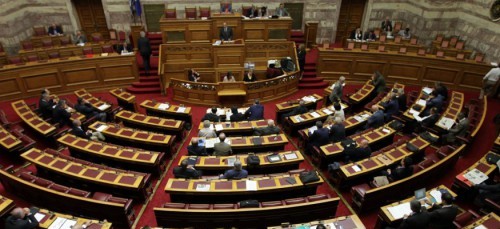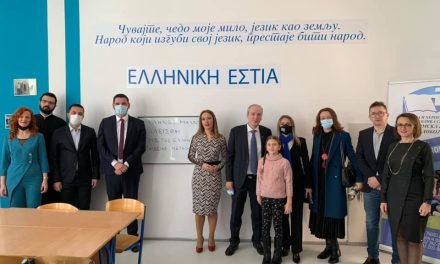The 2017 state budget was tabled in Parliament on Monday Nov. 22. The 2017 draft budget envisages that primary surpluses for 2017 and 2016 will significantly surpass targets, paving the way for measures to boost social policy in the coming years. The government’s initial forecasts – predicted a return to growth in 2017 – were included in the draft budget that was tabled on October 3. The 2017 budget includes full funding for the newly established Social Solidarity Income amounting to 760 million euros.
The primary surplus in 2017 is projected to reach 2.0 pct of GDP, surpassing a target of 1.75 pct set in the economic policy programme and confirming the positive trend of fiscal data. The Greek economy expected to grow by 2.7 pct after a contracting -0.3 pct rate in 2016, while the unemployment rate is projected to fall to 20.6 pct this year.
The country’s public debt is expected to ease to 176.5 pct of GDP in 2017, from 180.3 pct in 2016, although in absolute figures it is expected to rise to 319.2 billion euros in 2017 from 315.4 billion in 2016. The 2017 budget aims to maintain fiscal balance so as to complete a restoration of the country’s credibility and enable an exit from the fiscal adjustment programme the soonest possible, also to fairly distribute adjustment costs and to achieve a socially fair distribution of the benefits of an economic recovery.
The finance ministry, in an announcement, said “it is the third successive year that the government will achieve its goals, thanks to a prudent fiscal management, a gradual recovery of economic activity and an improvement in tax revenue”.
The draft budget also puts priority on strengthening and fortifying social protection and boosting public investments. For this reason, the budget incorporates a series of interventions, such as:
-expanding the implementation of a Solidarity Social Income with 760 million euros, covering more than 250,000 households living in poverty,
-strengthening health, education and social protection with an additional 300 million euros,
-contributing 100 million euros for the settlement of non-performing loans by over-indebted households with set income and asset criteria and
-raising the national leg of a Public Investments Programme by 250 million euros.
The debate on final draft before the parliament plenum will start on December 6 and end at midnight the following Saturday, December 10, with a roll call vote.
Recent statistical data: Signs of economic recovery
Recent official statistical data confirmed expectations of a recovery in the Greek economy from the third quarter of 2016, with a stronger-than-expected growth rate of 1.5 pct on an annual basis and 0.5 pct on a quarterly basis, as a result of high base effects, Alpha Bank said in its weekly economic report.
Alpha Bank’s analysts said “it is particularly encouraging the fact that the Greek economy’s resilience in GDP terms is combined with a gradual decline in unemployment rate to 23.4 pct of the workforce in August from 24.6 pct in August 2015”. The analysts noted a return of the Greek economy to positive growth rate would be significant if it could be combined with stronger growth rates in employment and reducing unemployment. They stressed that a reversal in the ratio between growth rates and productivity growth rates -expected from 2019 with the help of upgraded infrastructure from higher investments on machinery equipment and constructions in the 2017-2018 period- will have positive effects on labor productivity and could lead to an unemployment rate of below 1/5 of the workforce by the end of the next decade.
Eurobank, in a weekly economic bulletin, also said that positive messages coming from Greek economic trends offered signs of a stabilization in the economy. The bank’s analysts attribute an increase in real GDP to domestic demand factors.
Centre of Planning and Economic Research: Economic Outlook for Greece
The 31st issue of the Centre of Planning and Economic Research (KEPE)’s Greek Economic Outlook is published at a time when there is a general “wait and see” stance in view of the completion of the second evaluation of the consolidation program and the disbursement of the second tranche of the loan agreement, the submission of the 2017 State Budget, the Medium-Term Fiscal Strategy and the ongoing discussions concerning Greek debt relief. In this context, discussion is now focused on whether the Greek economy will recover in 2016 and what will be the level of growth in 2017. Public finances are examined through an analysis of the 2016 State Budget execution (p. 19-22) as well as the evolution and structure of public debt
“…From the figures of the State Budget execution itarises that in the first eight months of 2016 a higherprimary surplus than the estimate made by the2016 State Budget was achieved. This developmentis mainly due to the General Government’s expenditurerestraint. Moreover, the fact that we are close toreaching an agreement on the second assessment ofthe economic adjustment program with the country’slenders, as all the prerequisites have been alreadypassed by the parliament, the disbursement of thesub-tranche from the ESM will lead to greater stabilityof the Greek economy. Additionally, the refinancingof the market due to the disbursement of the tranche,with both the settlement of arrears, as well as the reimbursementof tax returns to legal entities and personalincome tax returns would lead the Greek economyback to growth. Finally, the new development plan ofthe country in connection with the privatization programcould be the levers that will drive the economy out of recession.”
Sources: Greek draft budget envisages 2.0 pct of GDP primary surplus in 2017; Statistical data offer more evidence of Greek economic recovery; Hellenic Statistical Authority: The Greek Economy














